 W
WThe Caesareum of Alexandria is an ancient temple in Alexandria, Egypt. It was conceived by Cleopatra VII of the Ptolemaic kingdom, the last pharaoh of Ancient Egypt, to honour her first known lover Julius Caesar. The edifice was finished by the Roman Emperor Augustus, after he defeated Mark Antony and Cleopatra in Egypt. He destroyed all traces of Antony in Alexandria, and apparently dedicated the temple to his own cult.
 W
WThe Cathedral of the Savior or La Seo de Zaragoza is a Roman Catholic cathedral in Zaragoza, in Aragon, Spain. It is part of the World Heritage Site Mudéjar Architecture of Aragon.
 W
WPilgrim Baptist Church is a historic church located on the south side of Chicago, Illinois, USA. The landmarked building was originally constructed for a synagogue, Kehilath Anshe Ma'arav. The church is notable both as an architectural landmark and for the cultural contributions by the congregation of the church. Located at 3301 S. Indiana Ave, the church is in the heart of Chicago's Bronzeville neighborhood.
 W
WThe Christianization of sites that had been pagan occurred as a result of conversions in early Christian times, as well as an important part of the strategy of Interpretatio Christiana during the Christianization of pagan peoples. The landscape itself was Christianized, as prominent features were rededicated to Christian saints, sometimes quite directly, as when the island of Oglasa in the Tyrrhenian Sea was christened Montecristo.
 W
WThe Church of the Dormition of the Holy Mother of God (Bogoroditsa) is a Bulgarian Orthodox church in the village of Uzundzhovo, Haskovo Municipality, Bulgaria. Built as a mosque during the Ottoman era, it was reconstructed in 1906 as a church.
 W
WThe Church of the Holy Archangels Michael and Gabriel, located in Piața Traian in the center of Brăila, Romania, is a Romanian Orthodox church.
 W
WThe Church of the Sagrario is a building attached to the north facade of the Jaén Cathedral, made due to the unevenness and damage caused by the Lisbon earthquake of 1755. The project for this work was designed by the Madrid architect Ventura Rodríguez in 1764, although it was executed by his nephew Manuel Martín Rodríguez. It was inaugurated in 1801 and was consecrated on March 22 of that year.
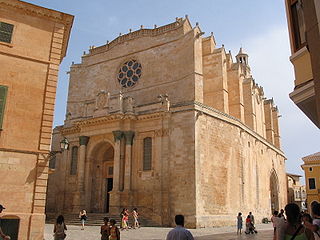 W
WThe Cathedral Basilica of Ciutadella de Menorca is a Roman Catholic church in Ciutadella de Menorca, in the island of Menorca, in Balearic Islands, Spain. It was constructed on the orders of King Alfonso III of Aragon "the Liberal", the conqueror of the island, in 1287 on the site of an old mosque.
 W
WThe Convent of Santo Domingo is a convent of the Dominican Order in the city of Cusco, Peru. Spanish colonists built it on top of Coricancha, the most important Inca temple of the capital of the people's empire.
 W
WThe basilica of Santi Cosma e Damiano is a titular church in Rome, Italy. The lower portion of the building is accessible through the Roman Forum and incorporates original Roman buildings, but the entrance to the upper level is outside the Forum. The circular building located at the entrance of the Forum, which now houses a small archeological exhibit, was built in the early 4th century as a Roman temple. It is thought to have been dedicated to Valerius Romulus, deified son of the emperor Maxentius. The main building was perhaps the library of an imperial forum.
 W
WThe Dolmen-Chapel of São Brissos is a small chapel located in the parish of Santiago do Escoural in the municipality of Montemor-o-Novo in Portugal. It consists of the conversion of a prehistoric tomb into a Christian cult building. The chapel has been classified as a Property of Public Interest since 1957.
 W
WGranada Cathedral, or the Cathedral of the Incarnation is a Roman Catholic church in the city of Granada, capital of the province of the same name in the Autonomous Region of Andalusia, Spain. The cathedral is the seat of the Archdiocese of Granada. Like many other cathedrals in Andalusia, it was built on top of the city's main mosque after the reconquest of Granada.
 W
WThe Mosque–Cathedral of Córdoba, officially known by its ecclesiastical name, the Cathedral of Our Lady of the Assumption, is the cathedral of the Roman Catholic Diocese of Córdoba dedicated to the Assumption of Mary and located in the Spanish region of Andalusia. Due to its status as a former Islamic mosque, it is also known as the Mezquita and as the Great Mosque of Córdoba.
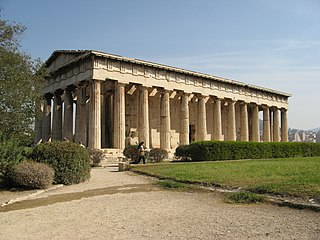 W
WThe Temple of Hephaestus or Hephaisteion, is a well-preserved Greek temple dedicated to Hephaestus; it remains standing largely intact today. It is a Doric peripteral temple, and is located at the north-west side of the Agora of Athens, on top of the Agoraios Kolonos hill. From the 7th century until 1834, it served as the Greek Orthodox church of Saint George Akamates. The building's condition has been maintained due to its history of varied use.
 W
WThe Assumption of the Virgin Cathedral is a Renaissance-style, Roman Catholic cathedral located in Santa María Square, opposite the Town Hall and the Episcopal Palace, in the center of Jaén, region of Andalusia, Spain.
 W
WMamre, full Hebrew name Elonei Mamre, refers to an ancient religious site originally focused on a single holy tree, growing "since time immemorial" at Hebron in Canaan. It is known from the biblical story of Abraham and the three visitors. The tree under which he had pitched his tent is known as the oak or terebinth of Mamre. Modern scholars have identified three sites near Hebron which, in different historical periods, have been successively known as Mamre: Khirbet Nimra, Ramat el-Khalil, and Khirbet es-Sibte. The last one contained an old oak tree identified by a relatively new tradition as the Oak of Mamre, which has collapsed in 2019, and is on the grounds of a Russian Orthodox monastery.
 W
WSanta Maria sopra Minerva is one of the major churches of the Roman Catholic Order of Preachers in Rome, Italy. The church's name derives from the fact that the first Christian church structure on the site was built directly over the ruins or foundations of a temple dedicated to the Egyptian goddess Isis, which had been erroneously ascribed to the Greco-Roman goddess Minerva.
 W
WThe Church of the Assumption of the Buda Castle, more commonly known as the Matthias Church, more rarely the Coronation Church of Buda, is a Roman Catholic church located in the Holy Trinity Square, Budapest, Hungary, in front of the Fisherman's Bastion at the heart of Buda's Castle District. According to church tradition, it was originally built in Romanesque style in 1015, although few references exist. The current building was constructed in the florid late Gothic style in the second half of the 14th century and was extensively restored in the late 19th century. It was the second largest church of medieval Buda and the seventh largest church of the medieval Hungarian Kingdom.
 W
WThe Iglesia de El Salvador is a church in Toledo, Spain completed in 1159.
 W
WThe Downtown Candlemas Church of the Blessed Virgin Mary, formerly known as the Mosque of Pasha Qasim is a Roman Catholic church in Pécs, Hungary, which was a mosque in the 16–17th century due to the Ottoman conquest. It is one of the symbols of the city, located in the downtown, on the main square. The current building, a hundred steps in length and in width, was built by Pasha Qasim the Victorious between 1543 and 1546. The mosque was converted to a church in 1702, after Habsburg-Hungarian troops reconquered the city. The minaret was destroyed by the Jesuits in 1766. One of the largest Ottoman constructions remaining in Hungary, the building still retains many Turkish architectural characteristics.
 W
WThe Cathedral Church of Saint Mary in Murcia, commonly called the Cathedral of Murcia, is a Catholic church in the city of Murcia, Spain. It is the cathedral of the Roman Catholic Diocese of Cartagena.
 W
WThe old main synagogue is a religious edifice in Segovia, Spain. Dating to the 14th century, it was converted into a convent of the nuns of Order of Saint Clare. The building was almost completely destroyed in a fire in 1899 and has been reconstructed since.
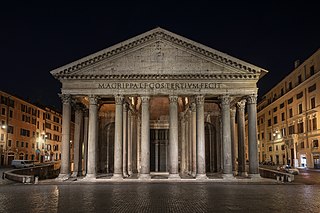 W
WThe Pantheon is a former Roman temple and since the year 609 a Catholic church, in Rome, Italy, on the site of an earlier temple commissioned by Marcus Agrippa during the reign of Augustus. It was rebuilt by the emperor Hadrian and probably dedicated c. 126 AD. Its date of construction is uncertain, because Hadrian chose not to inscribe the new temple but rather to retain the inscription of Agrippa's older temple, which had burned down.
 W
WThe Parthenon is a former temple on the Athenian Acropolis, Greece, dedicated to the goddess Athena, whom the people of Athens considered their patroness. Construction started in 447 BC when the Delian League was at the peak of its power. It was completed in 438 BC, although decoration of the building continued until 432 BC.
 W
WThe "Red Basilica", also called variously the Red Hall and Red Courtyard, is a monumental ruined temple in the ancient city of Pergamon, now Bergama, in western Turkey. The temple was built during the Roman Empire, probably in the time of Hadrian and possibly on his orders. It is one of the largest Roman structures still surviving in the ancient Greek world. The temple is thought to have been used for the worship of Egyptian gods – specifically Isis and/or Serapis, and possibly also Osiris, Harpocrates and other lesser gods, who may have been worshipped in a pair of drum-shaped rotundas, both of which are virtually intact, alongside the main temple.
 W
WThe Roman temple of Bziza is a well-preserved first century AD building dedicated to Azizos, a personification of the morning star in the Canaanite mythology. This Roman temple lends the modern Lebanese town of Bziza its current name as Bziza is a corruption of Beth Azizo meaning the house or temple of Azizos. Azizos is identified as Ares by Julian the Apostate.
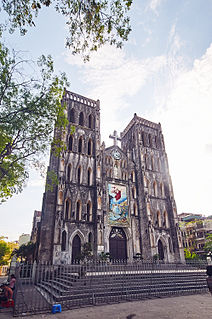 W
WSt. Joseph's Cathedral is a church on Nha Chung Street in the Hoàn Kiếm District of Hanoi, Vietnam. It is a late 19th-century Gothic Revival church that serves as the cathedral of the Roman Catholic Archdiocese of Hanoi. The cathedral was named after Joseph, the patron saint of Vietnam.
 W
WSan Sebastian is a redundant church in Toledo, Spain. The building was originally a mosque and was converted for use as church after the Reconquista. It is protected by the heritage listing Bien de Interés Cultural.
 W
WThe Sanctuary of Aphrodite of Aphrodisias was a sanctuary in ancient Aphrodisias dedicated to the goddess Aphrodite.
 W
WThe Synagogue of Santa María la Blanca is a museum and former synagogue in Toledo, Spain. Erected in 1180, according to an inscription on a beam, it is disputably considered the oldest synagogue building in Europe still standing. It is now owned and preserved by the Catholic Church.
 W
WThe Scolanova Synagogue is a medieval synagogue in Trani, Italy. It was built as a synagogue in the 13th century, confiscated by the church during a wave of antisemitism around the year 1380, and converted for use as a church known as Santa Maria in Scolanova. In 2006, the building was deconsecrated by the Church and returned to its original use.
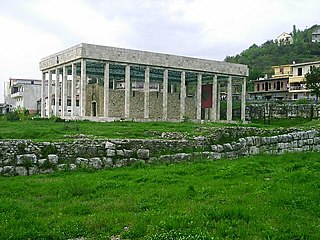 W
WThe Church of Saint Nicholas(Albanian: Kisha e Shën Nikollës/Kisha e Shna Kollit), former Selimije Mosque, or Church-Mosque of Lezhë (Kisha-Xhami) is a ruined historic church and mosque where the remains of Skanderbeg are said to be preserved in Lezhë, Albania. It is now used as Skanderbeg's Mausoleum in Lezhë, Albania.
 W
WThe Cathedral of St. Mary of la Seu Vella is the former cathedral church of the Roman Catholic Diocese of Lleida, in Lleida, Catalonia, Spain, located on top of Lleida hill.
 W
WThe Cathedral of Saint Mary of the See, better known as Seville Cathedral, is a Roman Catholic cathedral in Seville, Andalusia, Spain. It was registered in 1987 by UNESCO as a World Heritage Site, along with the adjoining Alcázar palace complex and the General Archive of the Indies. It is the fourth-largest church in the world as well as the largest Gothic church.
 W
WThe Shrine of Our Lady of Europe is a Roman Catholic parish church and national shrine of Gibraltar located at Europa Point. The church is dedicated to Our Lady of Europe, the Catholic patroness of Gibraltar.
 W
WThe Silves Cathedral is a former cathedral in the city of Silves, in the Algarve region of southern Portugal. A mosque, built during the Moorish rule of the Iberian Peninsula, was originally located in its current place, and was later mostly restructured and converted into a Catholic cathedral after the Reconquista. Although having some Baroque characteristics, it is mostly Gothic in nature and it is considered to be the main Gothic monument in the Algarve and one of the most important landmarks in southern Portugal. It was classified as a national monument on June 29, 1922.
 W
WSt. Anne's Church located in Trani, Apulia in Italy, was built as the Scolagrande Synagogue during the medieval period; the structure houses now the Jewish Section of the Diocesan Museum of Trani.
 W
WSt. Leonard's Church in Lipnica Murowana - a Gothic, wooden church located in the village of Lipnica Murowana from the fifteenth-century, which together with different churches is designated as part of the UNESCO Wooden Churches of Southern Lesser Poland.
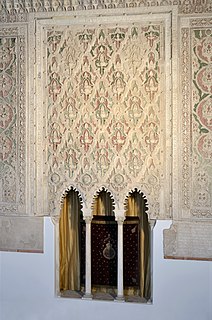 W
WThe Synagogue of El Tránsito, also known as the Synagogue of Samuel ha-Levi or Halevi, is a historic synagogue, church, and Sephardic museum in Toledo, Spain. It was built as an annex of the palace of Samuel ha-Levi Abulafia, treasurer to King Peter of Castile, in 1357. The synagogue was converted into a church after the expulsion of the Jews from Spain in 1492. It was briefly used as military barracks during the Napoleonic Wars of the early 1800s. It became a museum in 1910. Today it is formally known as the Sephardi Museum. The building is known for its rich stucco decoration, its Mudejar style, and its women's gallery.
 W
WTas-Silġ is a rounded hilltop on the south-east coast of the island of Malta, overlooking Marsaxlokk Bay, and close to the town of Żejtun. Tas-Silġ is a major multi-period sanctuary site with archaeological remains covering four thousand years, from the neolithic to the ninth century AD. The site includes a megalithic temple complex dating from the early third millennium BC, to a Phoenician and Punic sanctuary dedicated to the goddess Astarte. During the Roman era, the site became an international religious complex dedicated to the goddess Juno, helped by its location along major maritime trading routes, with the site being mentioned by first-century BC orator Cicero.
 W
WThe Temple at Uppsala was a religious center in the ancient Norse religion once located at what is now Gamla Uppsala, Sweden attested in Adam of Bremen's 11th-century work Gesta Hammaburgensis ecclesiae pontificum and in Heimskringla, written by Snorri Sturluson in the 13th century. Theories have been proposed about the implications of the descriptions of the temple and the findings of the archaeological excavations in the area, along with recent findings of extensive wooden structures and log lines that may have played a supporting role to activities at the site, including ritual sacrifice. The temple was destroyed by King Inge the Elder in the 1080s.
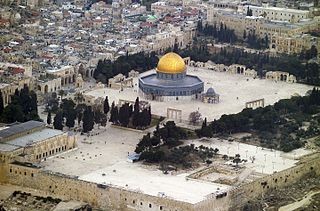 W
WThe Temple Mount, known to Muslims as the Haram esh-Sharif and the Al Aqsa Compound, is a hill in the Old City of Jerusalem that for thousands of years has been venerated as a holy site in Judaism, Christianity, and Islam alike.
 W
WThe Temple of Antoninus and Faustina is an ancient Roman temple in Rome, which was later converted into a Roman Catholic church, the Chiesa di San Lorenzo in Miranda or simply "San Lorenzo in Miranda". It is located in the Forum Romanum, on the Via Sacra, opposite the Regia.
 W
WThe Temple of Baalshamin was an ancient temple in the city of Palmyra, Syria, dedicated to the Canaanite sky deity Baalshamin. The temple's earliest phase dates to the late 2nd century BC; its altar was built in 115 AD, and the temple was substantially rebuilt in 131 AD. The temple would have been closed during the persecution of pagans in the late Roman Empire in a campaign against the temples of the East made by Maternus Cynegius, Praetorian Prefect of Oriens, between 25 May 385 to 19 March 388. With the spreading of Christianity in the region in the 5th century AD, the temple was converted to a church.
 W
WThe Temple of Bel, sometimes also referred to as the "Temple of Baal", was an ancient temple located in Palmyra, Syria. The temple, consecrated to the Mesopotamian god Bel, worshipped at Palmyra in triad with the lunar god Aglibol and the sun god Yarhibol, formed the center of religious life in Palmyra and was dedicated in AD 32. The temple would have been closed during the persecution of pagans in the late Roman Empire in a campaign against the temples of the East made by Maternus Cynegius, Praetorian Prefect of Oriens, between 25 May 385 to 19 March 388. Its ruins were considered among the best preserved at Palmyra, until they were further destroyed by the Islamic State of Iraq and Syria in August 2015. The arched main entrance into the temple is still intact, as well as its exterior walls and fortified gate.
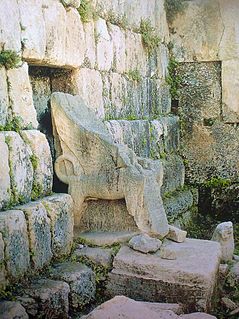 W
WThe Temple of Eshmun is an ancient place of worship dedicated to Eshmun, the Phoenician god of healing. It is located near the Awali river, 2 kilometres (1.2 mi) northeast of Sidon in southwestern Lebanon. The site was occupied from the 7th century BC to the 8th century AD, suggesting an integrated relationship with the nearby city of Sidon. Although originally constructed by Sidonian king Eshmunazar II in the Achaemenid era to celebrate the city's recovered wealth and stature, the temple complex was greatly expanded by Bodashtart, Yatan-milk and later monarchs. Because the continued expansion spanned many centuries of alternating independence and foreign hegemony, the sanctuary features a wealth of different architectural and decorative styles and influences.
 W
WThe Temple of Hercules Victor or Hercules Olivarius is a Roman temple in Piazza Bocca della Verità, in the area of the Forum Boarium close to the Tiber in Rome, Italy. It is a tholos - a round temple of Greek 'peripteral' design completely encircled by a colonnade. This layout caused it to be mistaken for a temple of Vesta until it was correctly identified by Napoleon's Prefect of Rome, Camille de Tournon.
 W
WThe Temple of Jupiter in Damascus was built by the Romans, beginning during the rule of Augustus and completed during the rule of Constantius II.
 W
WThe Temple of Kalabsha is an ancient Egyptian temple that was originally located at Bab al-Kalabsha, approximately 50 km south of Aswan. The temple was inscribed on the UNESCO World Heritage List in 1979, along with other outstanding examples of Nubian architecture including Abu Simbel and Amada.
 W
WThe Temple of Portunus or Temple of Fortuna Virilis is a Roman temple in Rome, Italy, one of the best preserved of all Roman temples. Its dedication remains unclear, as ancient sources mention several temples in this area of Rome, without saying enough to make it clear which this is. It was called the Temple of Fortuna Virilis from the Renaissance, and remains better known by this name. If dedicated to Portunus, the god of keys, doors and livestock, and so granaries, it is the main temple dedicated to the god in the city.
 W
WThe Primatial Cathedral of Saint Mary of Toledo, otherwise Toledo Cathedral, is a Roman Catholic church in Toledo, Spain. It is the seat of the Metropolitan Archdiocese of Toledo.
 W
WToulon Cathedral, also known as Sainte-Marie-Majeure, is a Roman Catholic church located in Toulon, in the Var department of France. The cathedral is a national monument. Construction of the church began in the 11th century and finished in the 18th century. From the 5th century onwards, it was the seat of the Bishops of Toulon, and since 1957 has been the ecclesiastical seat of the Diocese of Fréjus-Toulon.
 W
WThe Cathedral of Saint Mary of Tudela is a Roman Catholic cathedral located in Plaza Vieja in the center of Tudela, autonomous community of Navarre, Spain. The medieval building was originally a collegiate church. It became a cathedral with the creation of the Diocese of Tudela, which existed 1783-1851 and again 1889-1956. It is now a co-cathedral in the Archdiocese of Pamplona and Tudela.
 W
WThe Metropolitan Cathedral–Basilica of the Assumption of Our Lady of Valencia, alternatively known as Saint Mary's Cathedral or Valencia Cathedral, is a Roman Catholic parish church in Valencia, Spain.